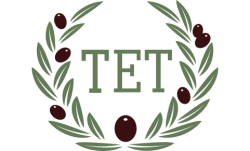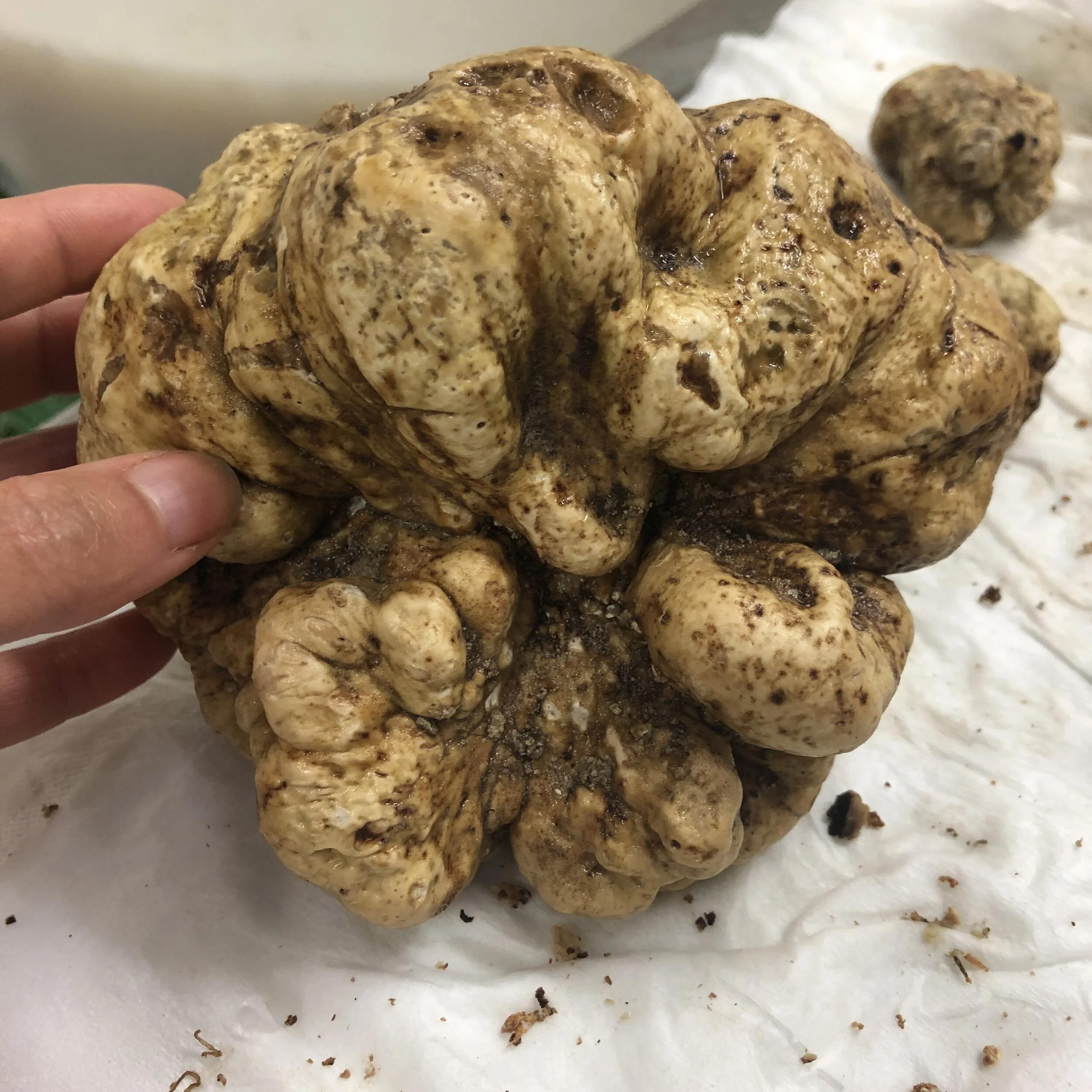How did the taste that Brillat-Savarin called “the diamond of the kitchen” become what food critic Jonathan Gold dubbed “the ketchup of the middle class?”
And how did the clamoring for a foodstuff whose heady aromatics, resulting from the catalyzation of a compound found in halitosis, foot odor, and flatulence to formaldehyde, get to the point where it needed to be produced artificially to keep up with demand?
Earth pimples? - history and science
Although he may not have been referring to the tuber magnatum, the white truffle, per se, Pliny the Elder sings the praises of truffles as the greatest of nature’s marvels. What amazed him most was how they seemed to be a product of storms, germinating without seed and forming no root. In an attempt to bring logic to bear, he likened them to blemishes or callouses, subcutaneous afflictions of the earth’s dermis.
Even after more than a thousand years, botanists had made little headway into unraveling the mystery. In 1552, Hieronymus Bock leaned on the spontaneous generation hypothesis, wherein entities sprang forth from the right combination of elements, saying: “[they are] neither plants, nor roots, nor flowers, nor seeds, … nothing other than the superfluous moisture of earth, trees, rotting wood, and other rotting things, … all mushrooms and truffles, especially the ones which are for eating, grow most frequently when there is thundery and rainy weather.”
Pier Antonio Micheli 1679-1737
Pier Antonio Micheli, the father of mycology, finally demonstrated that truffles were the product of spores. But the idea that truffles required an unusual combination of pieces to fall into place in order for them to flourish wasn’t too far off the mark.
Getting geeky: truffles belong to the ascomycota phylum of the fungi kingdom. They grow as symbionts, that is, in a symbiotic relationship with the roots of particular trees and flora, and in soil, moisture, sunlight, and temperature conditions that favor the formation of ectomycorrhizae. Their preferred companions are oak, elm, poplar, chestnut, willow, hazel, beech, birch, hemlock, fir, and pine trees.
Digging deeper - Hunting and cultivation
Urbani Srl, located in the countryside of the province of Perugia, is the oldest truffle distribution company in Italy. Today, they handle over 70% of the international truffle distribution and sales worldwide. As such, they deal with a staff of over 18,000, a chain that runs from omini - ‘old guys’ - seasoned truffle hunters and their trusty dogs, picking each and every truffle out of the dirt (although an electronic ‘nose’ has also been developed) to their exclusive distribution at Harrods. Truffles may be a marker for elegance and refinement, but it all begins with a guy digging around in the woods.
One of the favorite factoids about truffles is that pigs were once used to sniff out the bulbous gems - sows to be specific - because elements of the truffle aroma spectrum hit her the same way as the male swine pheromone androstenol. Might there be something similar in our own DNA that explains our attraction to truffles? Anyway, when she gets wind that love is in the air (or rather underground), she assumes a position of sexual receptivity and begins digging. You can see why trained dogs seemed a wise alternative. Imagine a sow on a leash. Not only are they unmanageable when driven by lust, they also tend to eat the profits. Dogs do not like truffles.
Replica of a foraging pig. Urbani Truffle Museum, Sant’Antolia di Narco, PG
Another method of locating truffles requires a keen eye. An insect called the sillia tuberiperda will hover above embedded truffles and strategically lay her eggs so that the larvae will have a food source nearby once they hatch. If you spot the flies hovering, you may well have found a truffle. With global warming, the larvae can be found inside the truffles well into the season, which has led to the precautionary measure of shaving the truffles onto the food in the kitchen and presenting the plate in a cloche so that the customer still gets the aromatic power hit without the unpleasantry of unexpected dinner guests.
And of course, the occasional worm in a truffle is said to enhance the quality, much like a splotch of bird poop landing on your shoulder from on high brings good luck.
white truffles - Città di Castello Truffle Festival
Although there has been some successful re-staging of the delicate balance of conditions conducive black truffles cultivation, the more prized white truffle, specifically the tuber magnatum, has thus far proven resistant to constructed environments.
Australia, whose truffle production is purely from truffle plantations, produced 15 tons of black truffles last year, compared to just under 15 tons in France, 30 in Italy, and about 60 in Spain. For distributors like Urbani Srl, who control about 70% of the world market, the Australian growing season allows them to keep truffles in circulation. Favorable environments have also been successfully created in Chile, Argentina, South Africa, New Zealand, and the USA.
There is no compromise in the taste of truffles cultivated on truffle plantations. On the contrary, some say they are better than the naturally occurring ones due to the pampered, controlled conditions.
The yield in Italy is decreasing yearly due to what has become a two-season climate of hot and dry / rainy, compounded with the fact that livestock is no longer brought into the woods to feed - and fertilize.
Truffle products: the lowdown
The craving for the truffle-scented olfactory turn-on that lights the pleasure circuits in the brain (an odor that Jeffry Steingarten maintains only anosomics, the smell blind, do not fall prey to) long ago tipped the scales between supply and demand, making truffles one of the world’s most expensive foods. In order to stretch the experience and preserve the volatile aromas, Urbani began manufacturing canned truffle products. An early example is this now obsolete favorite: canned whole thrushes with truffles.
Currently, Urbani has a catalogue of over 600 different truffle products in an effort to maintain the lead in this fiercely competitive market. Truffle festivals, like the celebration held every November in my town Città di Castello, are overrun with screaming banners and hundreds of precious jars of trufflesque concoctions, casting a “Truffles ‘R’ Us” air over the event.
Artifice - Catering to Generations X, Y, Z
The formula 2 CH3SH + H2C=O → CH3SCH2SCH3 + H2O - also known as 2,4- dithiapentane or its other name: bis(methylthio)methane, is unlikely to set anyone adrift reminiscing about their last trip to Italy, but that is the main volatile compound contributing to the ethereal quality of the white truffle.
This odiferous substance was identified and isolated in 1967. It is cheap, soluble, and stable and hits the pleasure circuitry in a way that allows for a gustatory suspension of disbelief - the quantum truffle experience (Schrödinger's truffle?). The commercial potential would unleash the imagination of enterprising product developers, but the one that would prove most popular was ‘truffle oil’ produced by simply dissolving the compound into a neutral tasting oil. It was added in concentrations that far exceeded actual truffles, which guaranteed a knock-out aroma when you opened the bottle - from 100-1000 times stronger. “For some people, if it doesn’t have a smell that bowls them over they don’t want it,” an Urbani representative told me.
Not only is the potency dictated by consumer expectations, black truffle products (spreads, butters, sauces etc.) are also inoculated with a shot of 2,4- dithiapentane, even though it is not part of the black truffle aroma spectrum. Each company creates is own aromatic cocktail as part of their trademark (see the ® below).
Flavored oils
The slippery part is the nomenclature. The meaning of ‘natural’ comes under scrutiny because natural and synthetic flavoring compounds have identical chemical structures - only their sources vary. Furthermore, ‘natural’ gives the impression that it is derived from truffles, but the aroma may be synthesized from sources that are natural - and yet have no truffle content. Hence ‘flavored’ is the more palatable way of saying ‘imitation.’ Even products that do contain symbolic quantities of actual truffle are reinforced with aromas. Consumers were so outraged at the lack of transparency and clear labeling that several companies were sued.
Urbani is unapologetic about the seeming duality of their product line: on the one hand, dedicated to the integrity of distributing the genuine article, and on the other, catering to the demand for artificially flavored products. As a multinational company earning over 60 per cent of their revenue from the ‘truffle-flavored’ line, there is no conflict - business is business. Although the US remains their largest market, sales are currently taking off in Asia, where chefs are exploring new flavors, and television cooking programs are expanding cultural horizons. Onwards and upwards.
Making a naturally infused truffle oil requires an inordinate amount of raw materials and is not cost effective. Considering there were sixty-two volatile aromatic compounds identified in white truffles, creating a natural infusion that harmoniously reflects the taste panorama of a real truffle is a fool’s errand. Urbani has taken on the Sisyphean challenge and concocted an oil aimed at satisfying the discerning palates of knowledgeable consumers. It is described as: “Extra virgin olive oil infused with white truffle,” containing “white truffle extract, natural flavorings, white truffles (tuber magnatum Pico) 0.1%” and contains seventeen of the sixty-two odiferous compounds. They very kindly gifted a bottle to me. While it may not elicit lordosis behavior, it does wonders to perk up a weekday pasta, frittata, or panino.
In this in depth study, funded in part by Urbani, all of the artificial and natural products tested (twenty in total - six of them Urbani’s) paled in comparison to the aromatic complexity of actual truffles. One product contained only two of the sixty two aromas. But when push comes to shove, consumers seeking a truffle fix will satisfy their needs with what is readily available and affordable, most settling contentedly for verisimilitude when they can’t make it to Italy for white truffle season.
My thanks go out to Urbani Srl and Adriano Berni for their courteous invitation to tour the Urbani facility.
and now on to our recipe
Tajarin al tartufo bianco
The way I most enjoy savoring white truffles is on Piemontese tajarin, a dialect word derived from tagliolini, thinly sliced pasta. It combines the two classic dishes that best exalt the truffle experience: eggs and fresh noodles. You should figure about 100g of flour and 3 egg yolks per person. Some people do 500g of flour, 1 whole egg and 12 yolks to serve five. Italian egg yolks are a deep orangey yellow and make gorgeous tajarin.
Combine the ingredients, knead for 10 minutes, wrap in plastic, and leave it to rest 20-30 minutes. Roll the dough out, either by hand or with whatever machine you have, then slice the noodles very thin. Boil the pasta in salted water and prepare a skillet of melted butter - 2 tablespoons per person. When the pasta is almost done, strain it and put toss it in the melted butter over medium heat. Test for doneness and add a ladle of the pasta water if needed. Plate up the pasta and cover with white truffle shavings. If you are a heretic, you can add some parmesan cheese or a couple grinds of white pepper, depending on the company you keep. Buon appetito!











